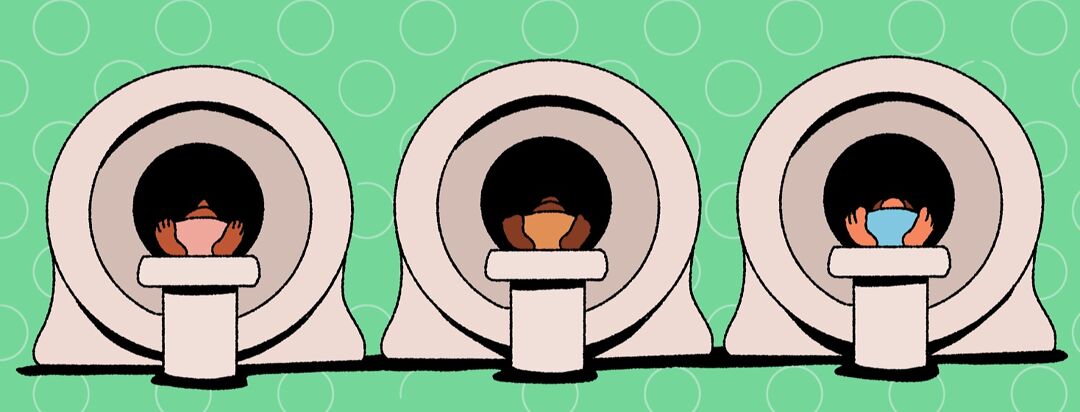The "Big Three" In Crohn’s and Colitis Testing
Living with Crohn’s disease or ulcerative colitis can often feel like being stuck in a maze of doctor visits, medications, and testing. If you’ve been in the IBD world for any length of time, you’ve probably encountered the "Big Three" in Crohn’s and colitis diagnostics: CT scans, MRIs, and colonoscopies.
Each of these tests has a place in IBD care, but let’s break down the pros and cons of each with a focus on what they really mean for us as patients.
CT scans: the speedy option
What it is: a CT scan is essentially a super-detailed X-ray that gives a cross-sectional view of your body. It’s often used in emergencies to get a quick picture of what’s happening inside.
Pros
- Fast and effective: the entire process is usually done within 10-15 minutes, making it ideal for emergencies or when answers are needed immediately.
- Accessible: most hospitals and imaging centers are equipped with CT scanners, so I've found it’s usually easy to schedule.
- Great for identifying blockages or abscesses: if you’re dealing with intense abdominal pain, this can pinpoint the cause quickly.
Cons
- Radiation exposure: CT scans involve higher levels of radiation than a standard X-ray. While one scan isn’t a big deal, multiple scans can add up over time.1
- Contrast dye issues: if you’ve ever had to drink the contrast solution or had it injected, you know it’s not the most pleasant experience. It can also cause allergic reactions or kidney issues for some.2-3
- Less detail in soft tissue: while great for emergencies, CT scans don’t always seem to provide the nuanced images doctors might need to assess inflammation or subtle changes.
MRI: the detail-oriented friend
What it is: MRI uses magnetic fields and radio waves to create highly detailed images of your body. In my experience, MRIs are often used to assess inflammation or complications in the small intestine.
Pros
- No radiation: MRI is a safer option for those of us who need repeat imaging over the years. Detailed imaging of soft tissues: If your doctor wants to evaluate inflammation, fistulas, or small bowel issues, MRI is king.
- Less invasive than a colonoscopy: it provides detailed internal views without needing a camera “up close and personal”.
Cons
- Time-consuming: an MRI can take 30 minutes to an hour, or longer, if you’re having an MRI enterography, which involves drinking contrast.
- Claustrophobia is real: being in the MRI machine feels like being stuffed into a loud, futuristic tube. If you’re claustrophobic, this can be a challenge.
- Contrast complications: some MRIs require a contrast dye injection, which can cause mild side effects (like nausea) or, in rare cases, allergic reactions.
- Cost: MRIs can be pricey, and insurance doesn’t always cover the full amount.
Colonoscopy: the gold standard
What it is: colonoscopies involve inserting a camera into your colon to directly visualize inflammation, ulcers, or other issues. While not everyone’s favorite, they’re a very effective diagnostic and monitoring tool.
Pros
- Direct visualization: your doctor sees exactly what’s happening in your intestines, which can mean more accurate diagnoses and treatment plans.
- Biopsies included: if your doctor needs a tissue sample, they can take one during the procedure.
- Essential for cancer screening: I've learned that regular colonoscopies are vital for detecting colon cancer, especially for those of us with long-term Crohn’s.
Cons
- Prep is a hassle: drinking the prep solution and spending hours in the bathroom is no one’s idea of fun.
- Invasive: the procedure itself, while relatively quick, is invasive and can feel intimidating.
- Requires sedation: most people are sedated, which means you’ll need someone to drive you home and may feel groggy for the rest of the day.
- Risk of complications: while rare, there’s a small risk of perforation or bleeding during the procedure.4
So, which test is best?
There’s no “one-size-fits-all” answer here. Your doctor will recommend a specific test based on your symptoms, history, and what they’re looking for. Each of these tests has its strengths and weaknesses, and honestly, most of us with IBD will encounter all three at some point in our journey.
Regardless of what test your doctor recommends, always advocate for yourself. Ask questions, understand why a specific test is being recommended, and don’t hesitate to speak up if you have concerns.
At the end of the day, these tests are tools to help us navigate this wild ride called Crohn’s (and ulcerative colitis) and the more informed we are, the better we can face them head-on!

Join the conversation